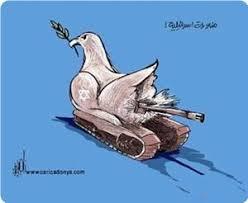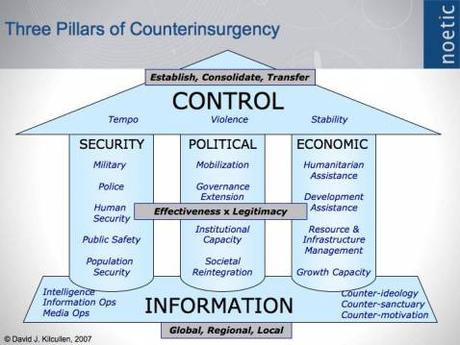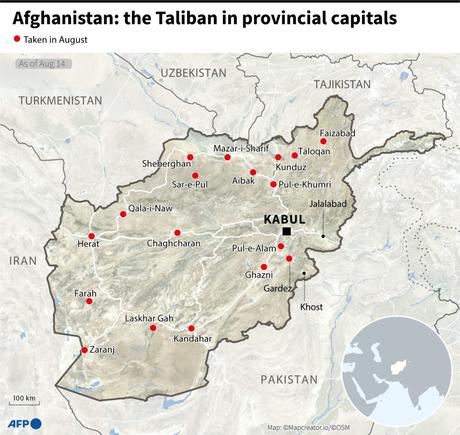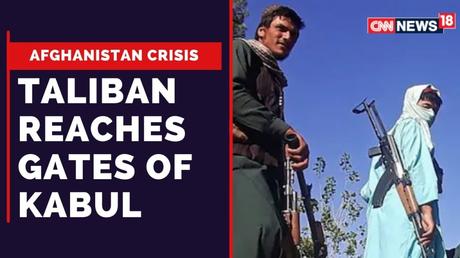Leave the Rag Heads to their rocks . Close the borders. (one alternative strategy in discussion forums)
On the beginning of August 2021 it was estimation that Kabul will collapse between 90-150 days. As of writing this article on August 14th it seems that Kabul – as the whole Afghanistan – will be in the hands of Taliban next week. There will be anyone to defend the capital, the government army and police are useless, other units in provincies have escaped without fighting and the Taliban has got their modern U.S. donated weapons. The situation is chaotic as time slot e.g. to evacuate U.S. collaborators, translators and their families is almost non existing.
This means that the West does not have old ally in Kabul and the rest of country. If they want to negotiate anything the only partner is the Taliban.
To me it’s clear that the central government in Kabul can not be effective partner while seeking any strategy for Afghanistan. On country side the Taliban are the residents of that place and historically they have proved how resistant they are towards the foreign invaders and their ideas.
Sun Tzu wrote in The Art of War following: “Strategy without tactics is the slow road to victory, but tactics without strategy is the noise before defeat.” I agree and would add that if there is no vision about endgame one does not even know is the road leading to victory or defeat.

Some historical background: Soviet invasion
In Afghanistan, prior to the Soviet (Russian) invasion, the Marxist–Leninist political party in Afghanistan -PDPA ( the Peoples Democratic Party of Afghanistan) – invited the USSR to assist in modernizing its economic infrastructure, mainly exploration and mining of minerals and natural gas. The USSR also sent contractors to build hospitals, roads and schools and to drill water wells. They also trained and equipped the Afghan army. The country was then renamed the Democratic Republic of Afghanistan (DRA), and the PDPA regime lasted, in some form or another, until April 1992.
Once in power (April 1978-), the PDPA moved to permit freedom of religion and carried out an ambitious land reform waiving farmers’ debts countrywide. Once in power, the PDP embarked upon a program of rapid modernization centered on separation of Mosque and State, eradication of illiteracy (which at the time stood at 90%), land reform, emancipation of women, and abolition of feudal practices. A Soviet-style national flag replaced the traditional black, red, and green. Traditional practices that were deemed feudal – such as usury, bride price and forced marriage – were banned, and the minimum age of marriage was raised. The government stressed education for both women and men, and launched an ambitious literacy campaign.Sharia Law was abolished, and men were encouraged to cut off their beards.
These new reforms were not well received by the majority of the Afghan population, particularly in rural areas; many Afghans saw them as un-Islamic and as a forced approach to Western culture in Afghan society.[They also made a number of statements on women’s rights and introduced women to political life.
As part of a Cold War, in 1979 the United States government began to covertly fund forces ranged against the pro-Soviet government, although warned that this might prompt a Soviet intervention. The secular nature of the government made it unpopular with conservative Afghans in the villages and the countryside who favoured traditionalist ” Islamic” restrictions on women’s rights and in daily life. Many groups, led by members of the traditional establishment were formed, some of them resorting to violence and sabotage to the country’s infrastructure and industry. under the umbrella of Mujahideen, or ” Holy Muslim Warriors”. The Mujahideen belonged to various different factions, but all shared, to varying degrees, a similarly conservative ‘Islamic’ ideology.
The Soviet Union intervened on December 24, 1979. Over 100,000 Soviet troops took part in the invasion backed by another one hundred thousand and by members of the Parcham faction. For over nine years the Soviet Army conducted military operations against the Afghan Mujahideen rebels. The American CIA, Pakistan and Saudi Arabia assisted in the financing of the resistance also because of the anti-communist stance. Among the foreign participants in the war was Osama bin Laden, whose MAK ( maktab al-Khidamat/Office of Order) organization trained a small number of Mujahideen and provided some arms and funds to fight the Soviets. Around 1988 MAK broke away from the Mujahideen to expand the anti-Soviet resistance effort into a world-wide Islamic fundamentalist movement.
The Soviets withdrew its troops in February of 1989, but continued aid to the government led by Mohammed Najibullah. Massive amounts of aid from the CIA and Saudi Arabia to the Mujahideen also continued. In 1991, the Soviet Union dissolved. All support for the Republic of Afghanistan stopped. In April 1992, the PDPA regime in Afghanistan collapsed. Fighting continued among the victorious Mujahideen factions, which gave rise to a state of warlordism. It was at this time that the Taliban developed as a politico-religious force, eventually seizing Kabul in 1996 and establishing the Islamic Emirate of Afghanistan. By the end of 2000 the Taliban had captured 95% of the country.
While the total Afghan population is 28,150,000, some 3.3 million Afghans are now involved in producing opium. Opium etc production and politics have interactive connection especially in Afghanistan. Earlier I have studied how US foreign policy tactics helped to create logistics between markets via Balkan route and producers of heroin. I have described the outcome as Fourfold or Quadruple Helix Model where government, underworld, Wahhabbi schools and international terrorism have win-win symbiosis.
During the Taliban’s rule, much of the population experienced restrictions on their freedom and violations of their human rights. Women were banned from jobs, girls forbidden to attend schools or universities. Communists were systematically eradicated and thieves were punished by amputating one of their hands or feet. Opium production was nearly wiped out by the Taliban by 2001.
COIN
An old CBS documentary – “Bombing Afghanistan“– made comparison of the Russian past and then current practice of a Yank in Afghanistan. A couple of extracts:
“During the Russian invasion we have not heard of 10 members of one family being killed by Russians in one incident. But the Americans did that, “remarked a Villager.
“We used to hate the Russians much more than Americans,” replied the Villager. “But now when we see all this happening, I am telling you Russians behave much better than the Americans.”
After U.S. military win over Taliban US President Obama finally announced his new counter-insurgency (aka “Coin”) strategy in Afghanistan – which continues mostly the strategy of his predecessor Mr. Bush. Generals and influential – if not decisive – military-industrial complex got what they want and once again USA is seeking military solution to mainly political problem. US mission is seize the initiative against a resurgent Taliban while building the capacity of Afghan forces so that American and NATO forces can gradually hand off security responsibilities to the Afghans. Also, support the further development of the Afghan economy and key Afghan civilian institutions.
Coin theory emphasises a “population-centric” over an “enemy-centric” approach. Coin is predicated on the idea that it is possible to win supporters for an insurgency by providing security and basic services, and ensuring the presence of a strong, legitimate government. Idea was to split the country in smaller units that can be controlled by warlords working with Washington. occupation forces are moving increasingly to hand over power directly to regional warlords and their militias. The foreign policy team that President Obama had assembled includes some of the same figures who advocated the ethnic-sectarian partition of Yugoslavia and Iraq. Obama’s Special Envoy to Af-Pak, Richard Holbrooke, authored the agreement that partioned Bosnia into Serb and Muslim-Croat republics in 1995, in effect rubber-stamping the ethnic cleansing that had forcibly removed populations during a three-year civil war. He also turned a blind eye when Serb civilians were expelled from Croatia the same year, and from Kosovo in 1999.

The US Army Field manual (2006) emphasises the importance of “troop density”, or the ratio of security forces to inhabitants: “20 counter-insurgents per 1,000 residents (or 1:50) is often considered the minimum troop density required for effective Coin operations”. The size of the US-led coalition force would need to be approximately 568,000 troops. Even adding in the 97,000 Afghan police officers and the 100,000-odd Afghan soldiers leaves the NATO-led force more than 200,000 counter-insurgents short of the “minimum”.
There is a yawning gap between Coin theory and practice. “It’s all fine on paper, but that doesn’t translate into success on the ground,“The Afghan army is useless and the police are corrupt,” (More in Will Coin work in Afghanistan?
The Talibans
The history of Afghanistan shows that they’ve practised pure Greek democracy at the village level for two millennia – to export today’s western democracy idea to Afghanistan without understanding this background may work in cabinets but not on the field. Maybe the best democratic idea could be use an emergency loya jirga (a temporary council traditionally made up of representatives from Afghan tribes and opposing factions used decide matters of national significance). Loya jirga with 1,500 to 2,000 delegates representing all of the major players and parts of the countries could resolve today’s problems like they have traditionally resolved them in the past.
A powerful grass roots movement has blossomed last decades in Afghanistan – it’s called Taliban. The Taliban insurgents are doing much more than the Afghan government to establish good governance and accountability. In the remote provinces, the Taliban’s efforts have reinforced two images: on the other hand an absent and/or corrupt Afghan central government and effective and accountable Taliban administration on the other. It seems that the Taliban is answering better the to the needs of ordinary citizens than US and their puppet government in Kabul.
According to some observers who closely monitor the Taliban’s activities, these are new efforts to set out their priorities by focusing on Afghani interests rather than holding to a wide global network.T the Taliban have become more watchful of the foreign Jihadists in Afghanistan. Foreign militant are now not allowed, like before, to carry out their activities independently.
The Taliban are mainly local Afghans who do not want to be occupied by any invading army, local Afghan nationalists resisting occupation. They may be ultra-concervative tyrans implementing sharia-law, drug smugglers and opium growers protecting their drug territories, foreign jihadists and the angry relatives of Afghans killed by coalition forces getting revenge. One does not need to like about Taliban nor accept their ideology, but one should agree that they more or less represent their country.

Map of Afghanistan locating the cities that have fallen to the Taliban in the past week, as of August 14 – AFP / AFP
" data-orig-size="1536,1456" sizes="(max-width: 1024px) 100vw, 1024px" data-image-title="Afghanistan: the Taliban in provincial capitals" data-orig-file="https://arirusila.files.wordpress.com/2021/08/afghanistan-conflict-taliban-1.jpg" data-image-description="" data-image-meta="{"aperture":"0","credit":"AFP","camera":"","caption":"Map of Afghanistan locating the cities that have fallen to the Taliban in the past week, as of August 14 - AFP \/ AFP","created_timestamp":"1628974388","copyright":"AFP or licensors","focal_length":"0","iso":"0","shutter_speed":"0","title":"Afghanistan: the Taliban in provincial capitals","orientation":"0"}" data-medium-file="https://arirusila.files.wordpress.com/2021/08/afghanistan-conflict-taliban-1.jpg?w=300" data-permalink="https://arirusila.wordpress.com/2021/08/15/afghanistan-in-or-out/afghanistan-the-taliban-in-provincial-capitals/" alt="" srcset="https://arirusila.files.wordpress.com/2021/08/afghanistan-conflict-taliban-1.jpg?w=1024 1024w, https://arirusila.files.wordpress.com/2021/08/afghanistan-conflict-taliban-1.jpg?w=150 150w, https://arirusila.files.wordpress.com/2021/08/afghanistan-conflict-taliban-1.jpg?w=300 300w, https://arirusila.files.wordpress.com/2021/08/afghanistan-conflict-taliban-1.jpg?w=768 768w, https://arirusila.files.wordpress.com/2021/08/afghanistan-conflict-taliban-1.jpg 1536w" class="wp-image-6707" data-large-file="https://arirusila.files.wordpress.com/2021/08/afghanistan-conflict-taliban-1.jpg?w=450" />Map of Afghanistan locating the cities that have fallen to the Taliban in the past week, as of August 14 – AFP / AFPMy view
In my view the probable outcome will be that in one month the whole Afghanistan is under the Taliban rule meaning sharia law, some ethnic cleansing, some massacres, throwing basic human rights to trash, big amount of Afghan refugees inside and outside the country and naturally a human catastrophe e.g. due lack of food. The international community will react to this with some high flow statements and humanitarian aid to refugee camps.
There is of course other possible scenarios but they are unlikely and/or expensive. One is humanitarian intervention better sooner than later. Fast decisions could be made only in U.S. and Russia and the best scenario would be a joint operation, first airstrikes and then ground operation.
After invasion the real works starts. From my point of view the future strategy towards Afghanistan – if the aim is to get some sustainability – should be based on two principles:
- Bottom-up principle, where the actions, development plans and administration are made starting from local, village level; not from high flown programmes made in Brussels or Washington.
- Integrated approach where security, economy, local participation/commitment and administration are not separate sectors.
In my opinion this time effective Coin operation – implemented be U.S. and Russia, financed partly EU i.a. – could be solution. Effective means that some 600 000 counter-insurgents/soldiers should be send to Afghanistan so soon as possible to work in cities, villages and country-side with local tribes. The idea is to disarm local Taliban troops and with local tribes start to build some basic public services, local government and economy with vision of even some human rights. After few years time might be right to start build national wide cooperation based on these local units, “cantons” or provinces. The outcome might be loose federation or confederation with minimal central governance.
So powerful international actors should quickly decide what to do with Afghanistan. My guess is that the actions will be minimal, meaning a few statements and some humanitarian aid. If they on the other hand go to humanitarian intervention they should do this this time right on grassroot level and not from top to bottom.


